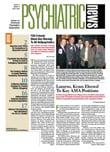Three years after the Food and Drug Administration (FDA) instituted a black-box warning for all second-generation antipsychotic (SGA) medications about increased risk of death in elderly dementia patients, a similar warning is being added to the labels of first-generation antipsychotics (FGAs) such as haloperidol and perphenazine.
The FDA announced its decision in mid-June after reviewing two epidemiological studies, both conducted in Canada, that were published in 2007. The two studies found mortality rates in elderly patients taking FGAs to be comparable to or higher than the rates in patients taking SGAs.
In a study by Sebastian Schneeweiss, M.D., and colleagues, the mortality hazard ratio in the FGA-treated elderly patients was 1.47 times that of SGA-treated patients within 180 days after starting the antipsychotic prescription. Included in this study were more than 37,000 people in British Columbia aged 65 and older who were started on antipsychotic medications. About one-third of these patients received FGA prescriptions, and the rest were given the newer SGAs. The study was published in the February 2007 Canadian Medical Association Journal.
The other study, reported by Sudeep Gill, M.D., M.Sc., and colleagues and published in the June 5, 2007, Annals of Internal Medicine, was conducted in patients with dementia aged 66 years and older in the province of Ontario. From public health databases, the authors constructed and compared three cohorts of FGA users, SGA users, and nonusers of antipsychotics based on dementia patients' status as community-dwelling or long-term-care residents. They ended up with a total of 27,259 pairs of antipsychotic-using and nonusing patients who were matched in demographics and clinical status.
New use of SGAs was associated with a significantly higher mortality rate than no antipsychotic use from 30 days to 180 days after the initial prescription (hazard ratio 1.31 in community-dwelling elderly patients and 1.55 in long-term-care patients). In addition, the mortality risk was slightly higher in FGA users than SGA users.
The prescribing labels of all antipsychotics are now required to carry a standard warning. “The boxed warning will say that elderly patients with dementia-related psychosis and treated with antipsychotics have an increased risk of death,” said Thomas Laughren, M.D., director of the Division of Psychiatry Products at the FDA's Center for Drug Evaluation and Research, at a June 16 press conference. The revised labels were to be finalized within 30 days of the mandate.
According to the “Information for Healthcare Professionals” bulletin posted on the FDA's Web site, “the methodological limitations in these two studies preclude any conclusion that conventional antipsychotics have a greater risk of death with use than atypical antipsychotics.” In other words, the agency chose not to differentiate the mortality risks of FGAs and SGAs on the basis of the two retrospective, nonrandomized, observational studies. The 2005 black-box warning for SGAs about increased risk of death in elderly dementia patients was based on the FDA's review of data from randomized, placebo-controlled clinical trials.
The FDA's decision “reflects the fact that enough information has emerged to warrant comparable language required for first-generation and second-generation antipsychotics,” Jeffery Lieberman, M.D., chair of the APA Council on Research, told Psychiatric News. He pointed out that the widespread use of SGAs in elderly dementia patients in the past decade had led to the accumulation of randomized clinical trial results that suggest an increased mortality risk compared with placebo. The risk with use of FGAs had been suspected, but not well studied, mainly because SGAs have been considered to cause fewer movement side effects and thus prescribed far more frequently for frail elderly patients.
“The lesson for clinicians is that these drugs carry certain liabilities, including potentially lethal consequences,” Lieberman said. Although the increase in risk is small, it is important to individual patients. Nonetheless, he acknowledged that physicians have very limited options in treating dementia-related psychosis and related behavioral symptoms.
No antipsychotics have been approved for treating psychosis or agitation in elderly patients with dementia. In fact, no drug has been approved for these symptoms. Laughren also emphasized that the black-box warning is not a contraindication, and clinicians still have the option of using these drugs for dementia patients at their discretion.
In a white paper released in July 2007, the American College of Neuropsychopharmacology (ACNP) reviewed clinical evidence and found that“ clinicians, patients, and caregivers are left with unclear choices of treatment for dementia patients with psychosis and/or severe agitation,” which often “cause considerable caregiver distress and hasten institutionalization of patients.”
Despite the risks associated with antipsychotic drugs, “there is insufficient evidence to suggest that psychotropics other than antipsychotics represent an overall effective and safe, let alone better, treatment choice for psychosis or agitation in dementia,” said the white paper.
Possible reasons for the association between antipsychotics and increased death rate remain unknown. The causes of death in studies of this relationship ranged from cancer to cardiovascular diseases, Laughren said.
The ACNP white paper recommended that physicians carefully determine the cause of psychosis and behavioral symptoms in dementia and discuss treatment options, including behavioral treatment strategies, with patients and families.
The FDA Information for Healthcare Professionals brochure is posted at<www.fda.gov/cder/drug/InfoSheets/HCP/antipsychotics_conventional.htm>.“ ACNP White Paper: Update on Use of Antipsychotic Drugs in Elderly Persons With Dementia” is posted at<www.acnp.org/asset.axd?id=40ed5fbf-b74e-444e-a926-49b4c5bc7069>.▪
